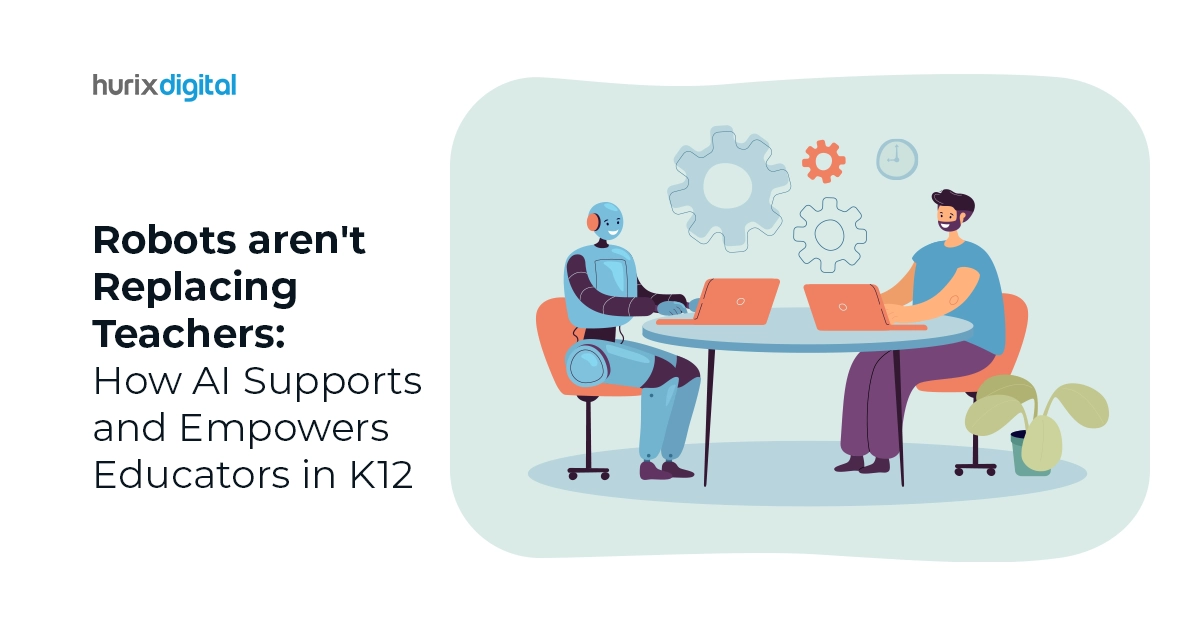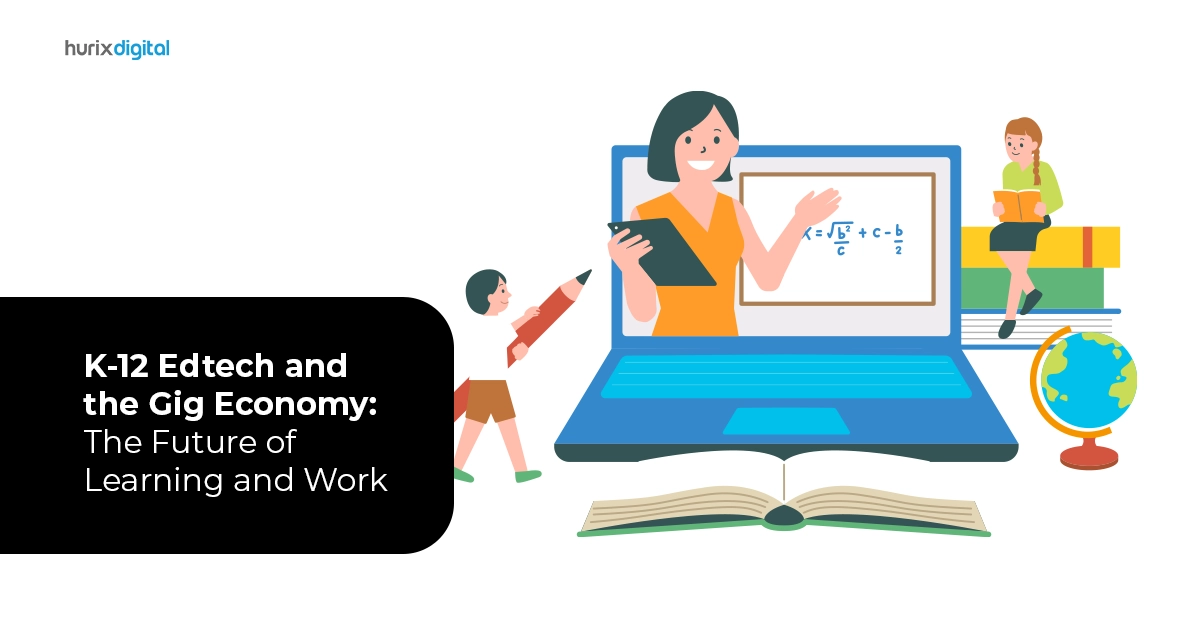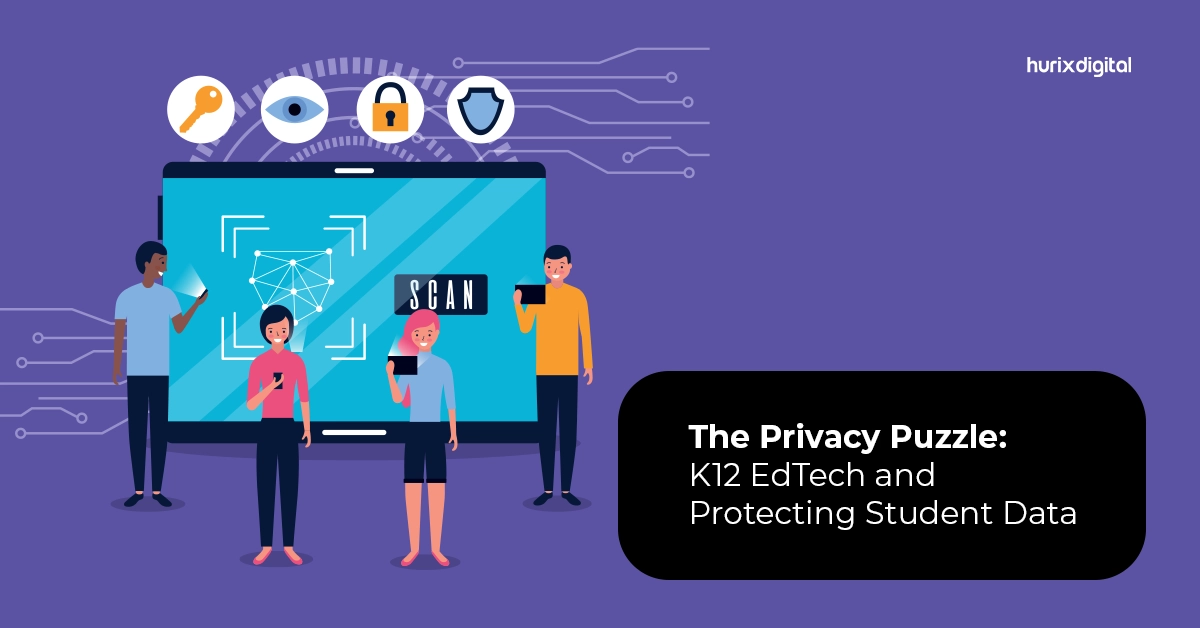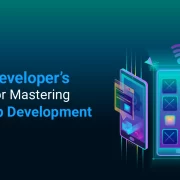
Robots aren’t Replacing Teachers: How AI Supports and Empowers Educators in K12
Summary
Explore how AI supports and empowers K12 educators. This blog addresses the role of AI in enhancing teaching practices and complementing the efforts of teachers.
EdTech is transforming K12 education by making it more accessible and interactive. The adaptive capabilities of AI have given rise to an array of technologies and tools that can personalize the entire experience.
Smart classroom technologies such as audiobooks and dictation software, digital content libraries, simulation games, augmented reality, and virtual reality today help millions of students and teachers alike.
According to a recent survey, 74% of teachers reported using technology that incorporates AI in their classrooms. Additionally, 68% of teachers believe that AI has a positive impact on student achievement.
However, a growing concern has emerged regarding the potential for robots and AI to replace teachers and educators in the classroom. In this article, we quash such speculation and instead focus on how human-AI collaboration in teaching is shaping up to be the next big thing in education.
Table of Contents:
- Can Teachers Be Replaced By Artificial Intelligence In The Classroom?
- AI in Education to Empower Educators in K12 EdTech
- AI in Education: The Future of Classrooms
Can Teachers Be Replaced By Artificial Intelligence In The Classroom?
The myths surrounding any new technology are part and parcel of its lifecycle. Edtech is no different. A common misconception about AI-assisted learning is that it can eventually wipe out the concept of teachers, and students will use AI in place of educators.
Let’s face the facts: that is not going to happen, and here is why:
- Human Connection: Empathy and understanding are at the core of the human experience, and teaching is no different. No AI or robot can replicate that.
- Emotional Intelligence: Teachers can understand and respond to the emotional needs of students in a way that AI cannot. A learner needs emotional guidance, especially in K12 education.
- Creativity: Creativity is a human quality, and teachers often inspire students to discover new things about themselves. An AI with its programming can try to replicate the process, but its success is debatable.
- Ethics and Values: Teachers play a crucial role in imparting ethical values and social norms. Human ethics cannot be inculcated by smart classroom technologies.
- Motivation: Teachers motivate and engage students. This is not a part of their job description, but a human need to inspire and help. AI cannot possibly be expected to hold up to those standards.
- Real-world Learning: AI can neither fathom nor teach real-world context and experiences.
- Guidance and Mentorship: Teachers have served society as guides and mentors for generations. These are roles that go beyond academic instruction. No robot can be expected to do the same
- Parent-Teacher Interaction: Parents often rely on teachers to know about their child’s academic and social prowess. A teacher understands how much parents need to know, what is vital information, and what can and perhaps should be kept from them. AI knows no such distinction.
- Lifelong Learning: Teachers instill the value of lifelong learning in students, a concept that goes beyond the curriculum. I cannot replace that.
- Role Model: Teachers serve as role models for students. They can influence their character and guide their life choices. This is something only humans can achieve.
The role of teachers goes well beyond a classroom and much further than a curriculum. No AI can take over that.
Also Read: How AI Can Improve K12 Education in the United States
AI in Education to Empower Educators in K12 EdTech
Now that we have established that the traditional teacher-student relationship is far too valuable to be replaced, let us look at the actual purpose of AI in education.
What are some ways human-AI collaboration in education can enhance the teaching experience, and what are some EdTech solutions for teachers that you can use to better guide the student? Let’s find out.
1. How Artificial Intelligence in The Classroom Creates a Better Teaching Experience
Artificial intelligence transforms the classroom, enhancing teaching with advanced insights and tailored support for a more engaging and effective learning journey.
- Personalized Learning: AI can analyze a student’s performance and tailor educational content to their learning style. This can help teachers individually guide students, even in a larger classroom environment.
- Efficient Grading: AI can automate grading and the entire process of testing. This frees up time for teachers to focus on activities that require human touch.
- Predictive analytics: AI can predict student performance trends. This helps teachers craft a far more effective curriculum for the coming year and tweak it when and as necessary for a better learning experience for students.
- Interactive Content: AI can create dynamic learning materials such as virtual labs and interactive textbooks. Teachers can use these technologies to engage even the more unruly students.
- Adaptive Testing: AI can adjust the difficulty of assessments based on a student’s ability. This helps teachers get a better grasp of a student’s ability and help them at a level from which they will most benefit.
- Language Processing: AI can assist in language learning and translation. This especially helps teachers to help students who are not native speakers of the medium of instruction, or even those with disabilities.
- Content Generation: AI can generate new learning materials based on curriculum guidelines. This allows teachers to create a better-quality set of materials in a shorter period.
- Real-time Feedback: AI can provide instant feedback to students. This allows not only students to correct themselves quickly but also allows teachers to continuously aid them in the process.
2. Smart Classroom Technologies that Enhance the Teaching Experience
Smart Classroom Technologies empower educators with innovative tools, fostering interactive learning environments and maximizing the teaching experience for optimal student engagement and understanding.
- Digital whiteboards: These allow teachers and students to write, draw, and interact with the content, making learning dynamic and fun.
- Projectors: They display digital content on a large screen, making it visible to everyone in the classroom, even those in the back.
- Tablets: These portable devices can run educational apps, e-books, and interactive learning materials.
- Education Apps: Software applications designed to enhance teaching and learning can boost the learning process.
- Learning Management Systems (LMS): Platforms that manage, track, and deliver courses and learning programs.
- Interactive Response Systems: Such systems allow teachers to pose questions and gather students’ responses during a lecture without spending extra time on it.
- Document Cameras: As an extension of projectors, they can display live images of objects, experiments, and texts to the entire class.
- Student Response Systems: These enable students to answer questions in real-time, providing immediate feedback.
- Online Assessment Platforms: These allow teachers to create, assign, and grade assessments digitally.
- Virtual Reality (VR) and Augmented Reality (AR) Tools: These systems allow for a more immersive teaching and learning experience.
Also Read: Ethical Considerations of AI in K12 Education: Navigating the Future of Learning
AI in Education: The Future of Classrooms
The integration of K-12 EdTech in classrooms has reached impressive heights, with a staggering 89% of teachers leveraging these innovations. But to implement these advancements, you need the right digital partner. And for that, Hurix Digital is at your service.
With custom content and curriculum development and an all-in-one suite of digital learning solutions, Hurix Digital has developed learning solutions for tomorrow. We offer features like a dynamic content library, diverse learning approaches, and assessment and proctoring solutions, among many others. Contact us to leverage AI in education in your learning programs today!

Senior Vice President
A Business Development professional with >20 years of experience with strong capability to sell new solutions and develop new markets from scratch. New Market Entry Specialist with experience of working in two of the largest emerging markets – China & India. Also covered other key markets in APAC, US, EU & ME. Exceptional experience of conceptualizing, ideating and selling new learning technologies like VR AR, etc. across multiple industry verticals.





